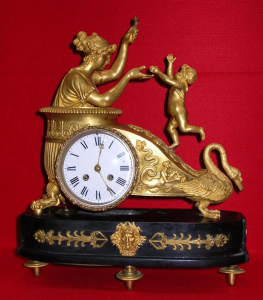What is the Difference Between Clock Repair and Clock Restoration?
Clock Repair
Most reputable clock shops use the same basic repair procedures on all clocks whether they are antiques or made within the past 60 years. Clock repair usually consists of the total movement disassembly, inspection of all parts and noting worn or damaged items needing repair, at this point the loose parts are cleaned with a proper clock cleaning solution using a cleaning machine, worn parts are replaced as new or repaired, all pivots are polished and worn bushings replaced. The final procedures are to reassemble the movement and test it. And all these procedures are typically called CLOCK REPAIR. Many times the reputable clock repair person can spend as much time removing bad repair techniques done previously by someone not properly trained to do the work, so when you take your clock to a shop ask to see their training certificate and some customer references.
Clock Restoration
Trained horologists having years of experience that was trained by other horologist or a reputable, experienced restorer typically performs antique clock restoration. The restoration process consists of performing clock repair procedures on the movement as well as cosmetically restoring the dial, the case and its wooden, metal and/or marble components using period procedures and process dating back to the time the clock was originally made. Proper restorations do not change the clock’s functionality, appearance or value.
Restoration requires a great deal of attention, time and patience as well as knowledge of the type of clock being restored, horologist may use period processes with modern materials and parts. Most antique clocks are intricate and have complex mechanisms; so antique clock restoration may take some time to complete, depending on the clock and the particular problems. The restorer must know the history of the specific timepiece and many disciplines to restore an antique clock; some of these include dial restoration, vintage carpentry methods, silvering, gilding, wheel cutting, lacquering, making lost or abused parts, cleaning and lubricating with the proper oils, disassembly and re-assembly, and then a thorough testing. There are three types of antique clocks the horologist is usually familiar with; the antique wall-clock that hangs on the wall, the floor standing tall case clocks or most commonly called the grandfather clock, and the mantel clocks, which sit on shelves or a piece of furniture and is the most common.
Clocks that failed were often repaired by less skillful or less knowledgeable repairers, or many times the owners does not want to spend the money and attempt the repair themselves. In many cases the correct parts were not available, could not be found and the repairer did not have the skills to reproduce them. The clock would then be made to work with wrong or inappropriate parts. An unskilled repairer may well have used copious amounts of solder in an attempt to repair a broken part, unfortunately, these repairs will not last long and the clock will quickly stop again. One common issue with antique clocks is that the owner expects them to run forever without servicing, cleaning or adequate lubrication. Depending on the environment, dirt can quickly builds up in the bushings and old lubrication dries and thickens. This condition quickly wears the pivot bushings and other moving parts. Clocks should be lubricated every three to six years, depending upon its environment, and cleaned every eight to ten years, depending upon the environment.
Restoration of a valued clock is a serious business and owners are sometimes emotionally attachment to a family heirloom, so having a valuable clock entrusted to someone for restoration is a matter for careful consideration. To choose the right restoration business for your clock requires research into the restorers’ background and past experience before a decision is made.
